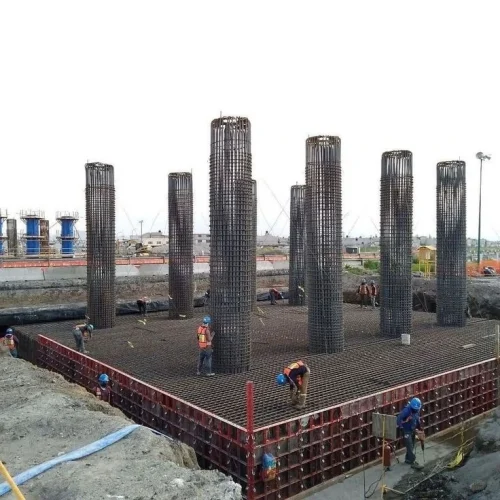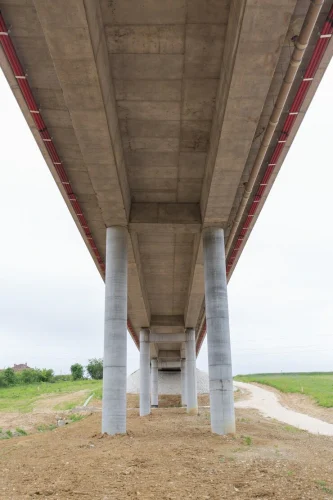
Best Pipes and Drains for Residential and Commercial Use
April 23, 2025
Plinth Beam Design: Strength, Size & Smart Applications
April 24, 2025Laying a strong foundation is the paramount step in the construction of a house. If the foundation is not strong, there is a high chance of structural damage in the long run. To tackle that, different types of pile foundations are used. Among the various types of piles, end bearing pile and friction pile stand out as fundamental solutions, each relying on distinct mechanisms to transfer the structural load to the ground.
In this blog, we will understand what end bearing pile and friction pile are, their key differences, advantages, disadvantages, and other elements.
What is Piling in Construction?
Source: Pinterest
Piling is a deep foundation technique that is used when the top layer of soil is not strong enough to support the load of the structure. In this process, strong and long, slender columns, which are known as piles, are put deep into a stronger ground. Then, these pillars help in transferring the load from the structure to the ground.
What is End Bearing?
End bearing refers to the way a certain type of pile transfers the weight of a structure to the ground. The key idea of end bearing is that most of the weight from the building is carried by the very bottom of the pile pushing directly on a strong layer of soil or rock located significantly below the surface.
These piles are used when a strong, stable layer of soil or rock exists at a depth that is reachable and economically feasible. When the building puts weight on the pile, that weight travels straight down the pile and is concentrated at its base. This base then bears directly on the strong underlying layer.
The strong layer provides significant resistance, pushing back up and preventing the pile from sinking. While there might be some friction between the sides of the pile and the surrounding soil, the primary support comes from this end bearing on the strong stratum.
What is Frictional Piles?
Frictional piles are used on soft mud where the hard, strong ground is way down deep. Instead of trying to reach that hard ground, they use special supports called friction piles. Unlike end bearings, these supports don't rely on their bottom to push against anything solid. Instead, they depend on the "stickiness" or grip of the mud all around their sides to hold up the building.
When the building's weight pushes down on the pile, the pile tries to sink. However, the soil all around the sides of the pile rubs against it and creates a force that stops it from going down too much.
Difference Between End Bearing Pile and Friction Pile
Here are the key differences between end bearing pile and friction pile in construction:
Features | End Bearing | Friction Piles |
Soil Condition | Suitable for deep, strong strata overlying weak soil | Suitable for deep, weak soil layers |
Load Bearing Capacity | Higher per pile | Lower per pile |
Settlement | Less settlement | Potentially more settlement |
Length of the Pile | Can be shorter if the strong stratum is shallow enough | Typically longer to maximize surface area |
Cost per Pile | higher due to depth and installation | lower per pile, but more piles may be needed |
Load Transfer | through base bearing | through skin friction |
Factors Influencing Selection of End Bearing Pile and Friction Pile:
Several factors guide the selection between end bearing pile and friction pile:
- Subsurface Soil Investigation
Before building, a thorough check of the underground soil is crucial. This involves digging holes and testing samples in a lab to understand the different soil layers, their strength, and how deep any solid, load-bearing ground is located. This information is key to choosing the right type of pile foundation.
- Magnitude and Type of Structural Load
The weight and nature of the building dictate how much support the foundation needs. A heavy building requires stronger piles and a greater load-carrying capacity compared to a lighter structure. Understanding these forces is essential for designing a stable foundation system.
- Allowable Settlement
All buildings sink slightly over time, but the acceptable amount of this sinking, known as allowable settlement, influences the choice of piles. Friction piles generally settle more than end-bearing piles, so the project's tolerance for settlement is a critical consideration.
- Economic Considerations
The overall cost of the piling system, including materials, installation methods, and the number of piles required, is a significant factor. Balancing the need for a strong foundation with budget constraints is a key aspect of the decision-making process
- Environmental Factors:
The surroundings of the construction site, such as accessibility for machinery, noise restrictions, and potential vibrations during installation, can also influence the selection of pile type and the methods used to put them in the ground. Minimizing disruption to the environment is an important consideration
Also Read: What are the stages of house construction?
Conclusion
Choosing between end bearing pile and friction pile is a really important decision when building foundations. End bearing piles are strong and don't sink much because they stand on the solid ground deep down. Whereas, friction piles work by gripping the softer dirt all around them. So, to pick the right one, we need to understand how they work, what kind of ground is there, and what's good and bad about each.
Also Read: Stunning Blue Bathroom Tile Ideas to Transform Your Space
Green Fortune Doors and Windows
Green Fortune Doors and Windows is where sustainability meets exquisite design. Our uPVC doors and windows are crafted with the perfect blend of durability, low maintenance, and aesthetic appeal, with a range of modern styles to complement any architectural vision. Choose Green Fortune and invest in quality, eco-conscious solutions that enhance the beauty of your house.
Also Read: Steps for building a foundation
Frequently Asked Questions (FAQs)
Q1: What is the difference between end bearing and friction pile?
A: The basic difference between end bearing and friction piles lies in how they transfer the weight of a structure to the ground.
Q2: What are the disadvantages of friction piles?
A: The big disadvantage of friction piles is that they don't work well if there's a lot of water in the ground or if the soil is very soft. In such situations, the pile might get pushed up out of the ground, or the soft soil could just wash away from around the pile.
Q3: Which type of pile, friction or end bearing settle more?
A: Friction piles are generally more likely to settle than end-bearing piles because they rely on the soil around them, which can compress. End-bearing piles rest on a much harder, less compressible layer.










